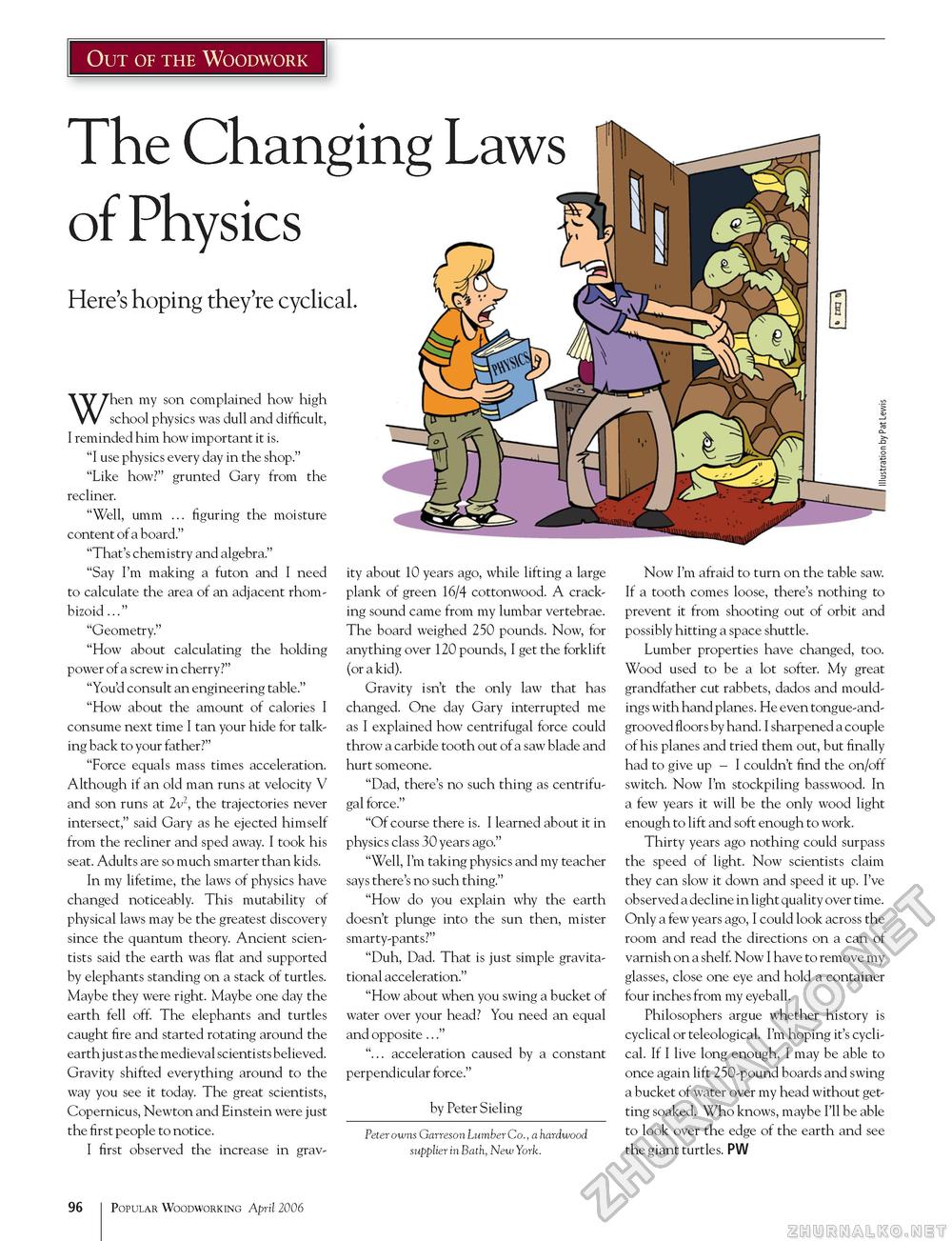Popular Woodworking 2006-04 № 154, страница 99
Out of the Woodwork The Changing Laws of Physics Here's hoping they're cyclical. When my son complained how high school physics was dull and difficult, I reminded him how important it is. "I use physics every day in the shop." "Like how?" grunted Gary from the recliner. "Well, umm ... figuring the moisture content of a board." "That's chemistry and algebra." "Say I'm making a futon and I need to calculate the area of an adjacent rhom-bizoid ..." "Geometry." "How about calculating the holding power of a screw in cherry?" "You'd consult an engineering table." "How about the amount of calories I consume next time I tan your hide for talking back to your father?" "Force equals mass times acceleration. Although if an old man runs at velocity V and son runs at 2v2, the trajectories never intersect," said Gary as he ejected himself from the recliner and sped away. I took his seat. Adults are so much smarter than kids. In my lifetime, the laws of physics have changed noticeably. This mutability of physical laws may be the greatest discovery since the quantum theory. Ancient scientists said the earth was flat and supported by elephants standing on a stack of turtles. Maybe they were right. Maybe one day the earth fell off. The elephants and turtles caught fire and started rotating around the earth just as the medieval scientists believed. Gravity shifted everything around to the way you see it today. The great scientists, Copernicus, Newton and Einstein were just the first people to notice. I first observed the increase in grav ity about 10 years ago, while lifting a large plank of green 16/4 cottonwood. A cracking sound came from my lumbar vertebrae. The board weighed 250 pounds. Now, for anything over 120 pounds, I get the forklift (or a kid). Gravity isn't the only law that has changed. One day Gary interrupted me as I explained how centrifugal force could throw a carbide tooth out of a saw blade and hurt someone. "Dad, there's no such thing as centrifugal force." "Of course there is. I learned about it in physics class 30 years ago." "Well, I'm taking physics and my teacher says there's no such thing." "How do you explain why the earth doesn't plunge into the sun then, mister smarty-pants?" "Duh, Dad. That is just simple gravitational acceleration." "How about when you swing a bucket of water over your head? You need an equal and opposite . " "... acceleration caused by a constant perpendicular force." by Peter Sieling Peter owns Garreson Lumber Co., a hardwood supplier in Bath, New York. Now I'm afraid to turn on the table saw. If a tooth comes loose, there's nothing to prevent it from shooting out of orbit and possibly hitting a space shuttle. Lumber properties have changed, too. Wood used to be a lot softer. My great grandfather cut rabbets, dados and mouldings with hand planes. He even tongue-and-grooved floors by hand. I sharpened a couple of his planes and tried them out, but finally had to give up - I couldn't find the on/off switch. Now I'm stockpiling basswood. In a few years it will be the only wood light enough to lift and soft enough to work. Thirty years ago nothing could surpass the speed of light. Now scientists claim they can slow it down and speed it up. I've observed a decline in light quality over time. Only a few years ago, I could look across the room and read the directions on a can of varnish on a shelf. Now I have to remove my glasses, close one eye and hold a container four inches from my eyeball. Philosophers argue whether history is cyclical or teleological. I'm hoping it's cyclical. If I live long enough, I may be able to once again lift 250-pound boards and swing a bucket of water over my head without getting soaked. Who knows, maybe I'll be able to look over the edge of the earth and see the giant turtles. PW 96 Popular Woodworking April 2006 |







